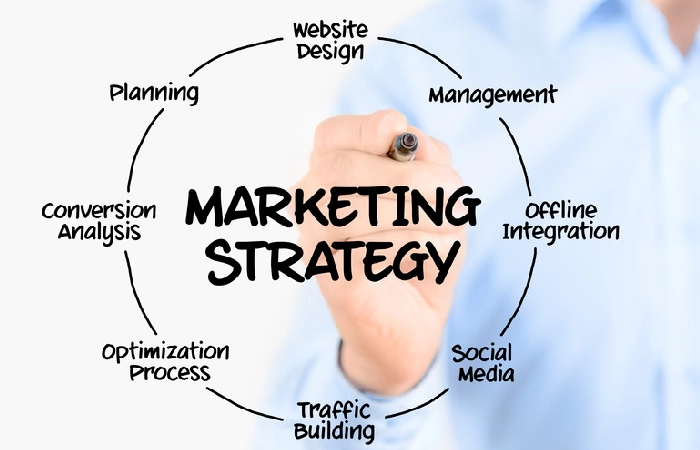About Marketing Strategies that Work for Small Businesses
The Marketing strategies that work for small businesses: You have an excellent idea for a company. You have everything ready, including your logo and location, and now you need to find your customers. What? Through an established small business marketing strategy.
You can propose the best creation or service worldwide, but that alone won’t help if your possible customers can’t find you. This is why you want a great marketing strategy, even if you are a small business.
Under this, we have a collective list of 9 small business marketing strategies that will increase your business discernibility and attract lots of new customers.
Types of Marketing Strategies that Work for Small Businesses

1. Branding – Establish a Clear Identity
It would aid if you had a clear identity to communicate what your company is, does, and stands for. Once you know what your business stands for, you need to:
- An appropriate name
- A logo
- Colors and images that convey this to your customers
There are many ways to do this, including hiring an outworker or working with a recognized agency. Consider how big businesses like Starbucks or McDonald’s are evident by their brands, logos, and colors.
Once you consume your logo, be sure to put it everywhere:
- Advertising;
- Business cards;
- Envelopes;
- Email signature, and so on.
- The goal is to make brand awareness and visibility.
Also, you shouldn’t just “rubber stamp” your logo somewhere – your brand should be memorable even after the logo is removed.
The language used in social networks or offline ads, the content produced, and the campaigns developed must reflect corporate values.
2. Recognize Your Business and Know Your Customers
One of the marketing tips for small businesses is to have a well-defined customer segment to act efficiently and assertively.
A mutual misconception is that there is a unique type of small business marketing strategy that you can follow and expect great results, no matter your business. This is not true, as all companies are different, and they all have additional requirements.
Before choosing which elements to incorporate into your overall marketing strategy, you must think carefully about your target customers.
- What is your demographic profile?
- How old are you?
- Where do you live?
- What services do they use?
- How do they find your product?
Be clear about the details of who you are so you can develop a more effective and targeted overall strategy that targets the channels most likely to drive results for you.
3. Use Facebook Ads
Facebook ads are one of the most acceptable ways to target a specific group. Your advertising can focus on the following:
- Years
- Sex
- Location
- Interests
- Habits, and so on.
The system is easy to use and relatively inexpensive, making the platform an excellent marketing strategy for small businesses to range the maximum number of potential customers quickly.
4. Have a Great Website
If there’s one thing that fits people away from your business, it’s a poorly designed website. Think about it, you’ve done the hard part of getting a click and driving the customer to your site, and they discover that the site isn’t user-friendly, hard to navigate, or not logically planned.
It’s an easy fault to avoid, so don’t make this fundamental mistake.
So if you want to organize your small business to get more customers, start your marketing actions with a simple, direct, and complete website.
5. Understand the Power of SEO
One of the most significant habits to drive web traffic to your website is finished Google Search. However, even when Google vicissitudes its search algorithms, you must still optimize your site keyword to safeguard it and ensure it ranks well for searches.
It is well known that the insertion of your website on the first page of Google results dramatically increases your odds of getting a click. So do whatever it takes to make unquestionable you’re there.
Just as essential as knowing what to do to rank first in Google, it’s also important to know what not to do!
6. Don’t Forget Email: The Power of Email List Segmentation
A small business marketing strategy that focuses on email offers many benefits as a marketing channel:
- It is easy to do
- Easy to automate
- Allows instant communication
- Cost a little bit
You can reach many prospects with the highest open rates, especially if you segment your list.
Once you’ve added someone’s address to your email list, provide attractive, valuable, and relevant content that people will open instead of immediately deleting it or sending it to their “spam” box. Otherwise, you are wasting your time.
The key idea is to get people to reappear on your website later when they can buy your creation. Email principals still have one of the top change rates on any foundation.
I think it’s great, but I don’t know where to twitch. So we distinct another video, this time on how to generate an email marketing strategy or, in its place, an email marketing strategy in repetition using a free tool like MailChimp.
Beforehand, it is interesting to emphasize that these types of systems can work for a while so that you can feel the results of the strategy. Still, the truth is that finding customized IT solutions for small businesses can also be even more efficient in marketing.
7. Use Google My Business
O Google My Business is handy for businesses that have a local client improperly. When people in your local area search Google for the creation or service you offer, it’s an excellent method to get your business to the top of that hunt.
When potential clients opinion your profile and see good appraisals at the top, your business automatically gains honesty, and people are more likely to have faith in you.
For example, a survey on “Business Consulting” carried out in Juiz de Fora, Minas Gerais, highlights the best-performing companies in the region registered in Google Meu Negócios.
8. Ask for References
This is the most used small business marketing strategy since your great-grandmother’s time!
Leverage your current customers to produce more business. For example, you can make a referral program to encourage customer transmissions.
It’s hard to abridge here as this can take many forms depending on your business. However, if you offer rewards like free products, giveaways, discounts, or anything else, your previously content customers will be pleased to bring you more principles.
The other benefit of referrals is that when your customers refer their friends to you, their friends are more likely to trust you automatically. Because of this, referral leads offer a much higher conversion rate than many other channels.
9. Use Google Adwords
Though Google Adwords is more comfortable than many other small business publicity strategies, you should still reproduce it because, if done correctly, it can be a potent marketing tool.
Remember, the key to this whole strategy is getting people to find you when they Google. Using Google AdWords can significantly increase your chances of people searching for your name instead of your competitor’s. See the example below.
Focus on What of Marketing Strategies for Small Business?

There are many dissimilar marketing channels and dissimilar small business marketing strategies that you can use to upsurge your visibility. But, most highly, don’t be frightened to try other marketing strategies and focus on what works most acceptably for you and your commercial.
Digital marketing is a lucrative way to reach your customers, especially for small businesses.
In addition to the cost of a campaign created according to the financial capabilities of each company, the platforms allow such precise customer segmentation that it increases the ROI of the actions and generates more business.
In short, when it comes to small business marketing strategies, digital marketing is king!
The certainty is that technology is showing daily to be the right arm for owners and directors in their goal to reduce prices and increase productivity.
Conclusion
From the above deliberations, we can conclude that a marketing strategy helps as the main link between marketing preparation and the analysis of the company’s state, on the one hand, and the development of specific programs, on the other.
Also Read: Lead Nurturing – The Six Strategies That Convert Lead Nurturing



